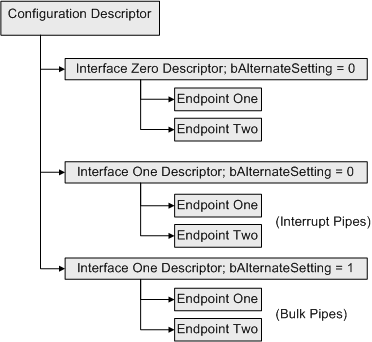|
||
| Products Download Events Support Videos | ||
Technical Support
On-Line Manuals
RL-ARM User's Guide (MDK v4)
Interface Descriptor
The Interface Descriptor describes a collection of endpoints. This interface supports a group of pipes that are suitable for a particular task. Each configuration can have multiple interfaces. The interface can be selected dynamically by the USB host. The Interface Descriptor can associate its collection of pipes with a device class, which in turn has an associated class device driver within the host operating system. Typically, the device class is a functional type such as a printer class or mass storage class.
An interface descriptor never includes Endpoint 0 in the number of endpoints. If an interface uses only Endpoint 0, then the field bNumEndpoints must be set to zero.
If no class type has been selected for the device, then none of the standard USB drivers is loaded, and the developer has to provide its own device driver.
| Offset | Field | Size | Value | Description |
|---|---|---|---|---|
| 0 | bLength | 1 | Number | Size of this descriptor in bytes. |
| 1 | bDescriptorType | 1 | Constant | Device Descriptor Type. |
| 2 | bInterfaceNumber | 1 | Number | The number of this interface. Zero-based value, identifying the index in the array of concurrent interfaces supported by this configuration. |
| 3 | bAlternateSetting | 1 | Number | Value used to select this alternate setting for the interface identified in the prior field. Allows an interface to change its settings on the fly. |
| 4 | bNumEndpoints | 1 | Number | Number of endpoints used by this interface (excluding endpoint zero). If this value is zero, this interface only uses the Default Control Pipe. |
| 5 | bInterfaceClass | 1 | Class | Class code (assigned by the USB-IF). A value of zero is
reserved for future standardization. If this field is set to FFH, the interface class is vendor-specific. All other values are reserved for assignment by the USB-IF. |
| 6 | bInterfaceSubClass | 1 | SubClass | Subclass code (assigned by the USB-IF). If the bInterfaceClass field is reset to zero, this field must also be reset to zero. If the bInterfaceClass field is not set to FFH, all values are reserved for assignment by the USB-IF. |
| 7 | bInterfaceProtocol | 1 | Protocol | Protocol code (assigned by the USB). If an interface supports class-specific requests, this code identifies the protocols that the device uses as defined in the device class. If this field is reset to zero, the device does not use a class-specific protocol on this interface. If this field is set to FFH, the device uses a vendor-specific protocol for this interface. |
| 8 | iInterface | 1 | Index | Index of string descriptor describing this interface. |
For example, two device with different interfaces are needed. The
first interface, Interface Zero, has the field
bInterfaceNumber set to zero.
The next interface, Interface One, has the field
bInterfaceNumber set to one and the field
bAlternativeSetting also set to zero (default). It is possible
to define an alternative setting for this device, by leaving the
field bInterfaceNumber set to one, but with the field
bAlternativeSetting is set to one instead of zero.
The first two interface descriptors with bAlternativeSettings equal to zero are used. However, the host can send a SetInterface() request to enable the alternative setting.

ProductsDevelopment Tools |
Hardware & Collateral |
Downloads |
Support |
Contact |
